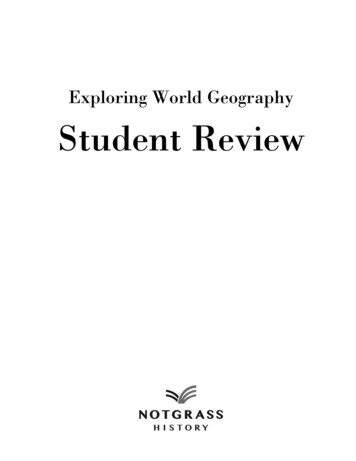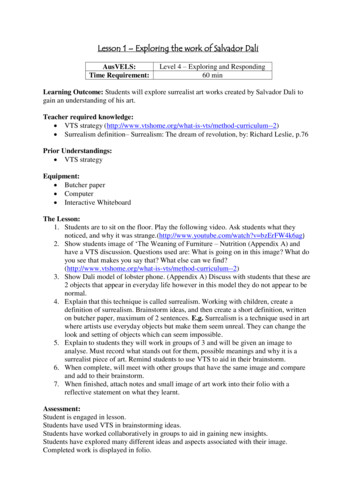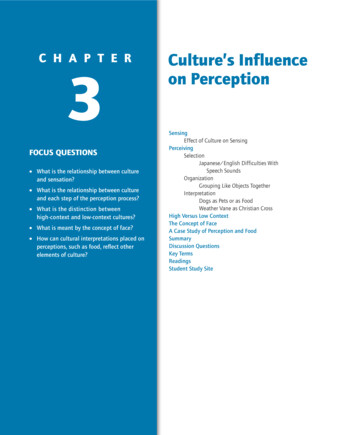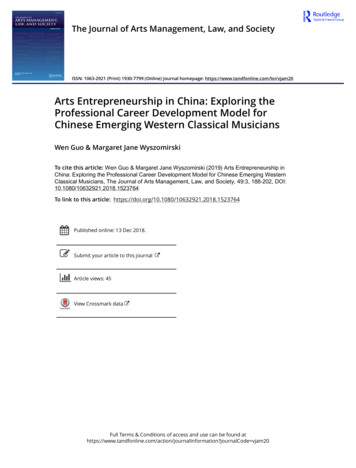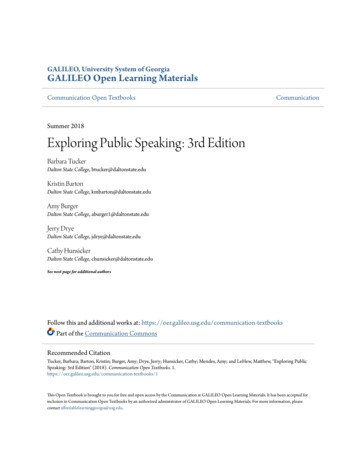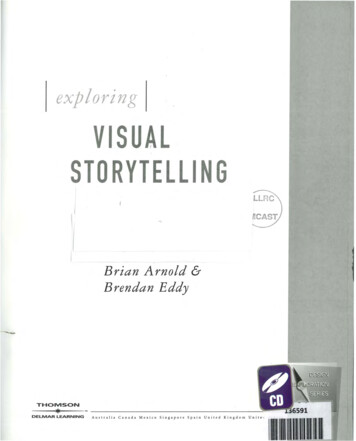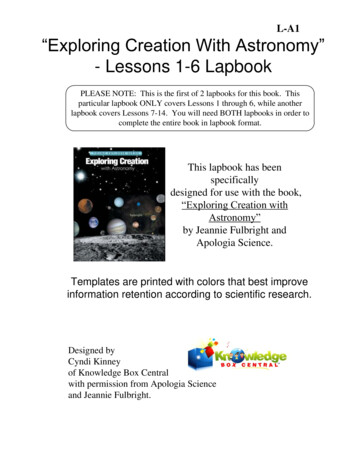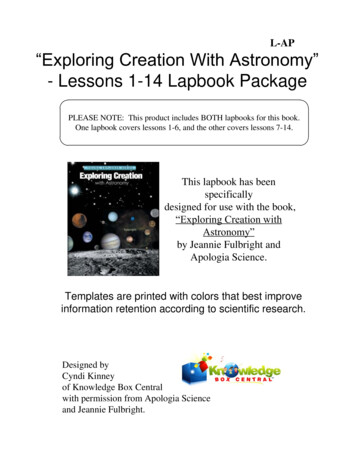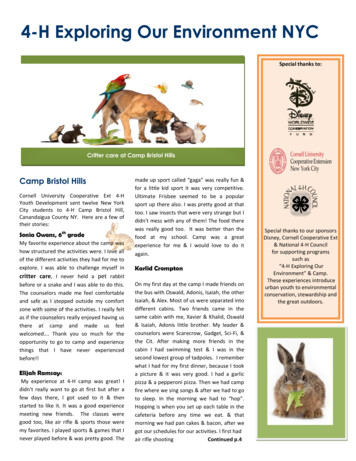
Transcription
4-H Exploring Our Environment NYCSpecial thanks to:Critter care at Camp Bristol HillsCamp Bristol HillsCornell University Cooperative Ext 4-HYouth Development sent twelve New YorkCity students to 4-H Camp Bristol Hill,Canandaigua County NY. Here are a few oftheir stories:Sonia Owens, 6th gradeMy favorite experience about the camp washow structured the activities were. I love allof the different activities they had for me toexplore. I was able to challenge myself incritter care, I never held a pet rabbitbefore or a snake and I was able to do this.The counselors made me feel comfortableand safe as I stepped outside my comfortzone with some of the activities. I really feltas if the counselors really enjoyed having usthere at camp and made us feelwelcomed . Thank you so much for theopportunity to go to camp and experiencethings that I have never experiencedbefore!!Elijah Ramsay:My experience at 4-H camp was great! Ididn't really want to go at first but after afew days there, I got used to it & thenstarted to like it. It was a good experiencemeeting new friends. The classes weregood too, like air rifle & sports those weremy favorites. I played sports & games that Inever played before & was pretty good. Themade up sport called “gaga” was really fun &for a little kid sport it was very competitive.Ultimate Frisbee seemed to be a popularsport up there also. I was pretty good at thattoo. I saw insects that were very strange but Ididn't mess with any of them! The food therewas really good too. It was better than thefood at my school. Camp was a greatexperience for me & I would love to do itagain.Karlid CromptonOn my first day at the camp I made friends onthe bus with Oswald, Adonis, Isaiah, the otherIsaiah, & Alex. Most of us were separated intodifferent cabins. Two friends came in thesame cabin with me, Xavier & Khalid, Oswald& Isaiah, Adonis little brother. My leader &counselors were Scarecrow, Gadget, Sci-Fi, &the Cit. After making more friends in thecabin I had swimming test & I was in thesecond lowest group of tadpoles. I rememberwhat I had for my first dinner, because I tooka picture & it was very good. I had a garlicpizza & a pepperoni pizza. Then we had campfire where we sing songs & after we had to goto sleep. In the morning we had to “hop”.Hopping is when you set up each table in thecafeteria before any time we eat. & thatmorning we had pan cakes & bacon, after wegot our schedules for our activities. I first hadair rifle shootingContinued p.4learned I am left eye dominant. I hit noSpecial thanks to our sponsorsDisney, Cornell Cooperative Ext& National 4-H Councilfor supporting programssuch as“4-H Exploring OurEnvironment” & Camp.These experiences introduceurban youth to environmentalconservation, stewardship andthe great outdoors.
Exploring Our EnvironmentThomas Reber, Hunter College HSOver the course of 5 weeks 4-H teeninstructors worked with one hundredth th5 -8 graders in an 8 part summerenvironmentaleducationcourse.Students covered everything from carbonfootprint & invasive species tocartography through hands on curriculum“Exploring the Environment – Earth’sCapacity”. Preceding the start of classeseach teen instructor was handed achapter from the curriculum and wascharged to grow it into an hour longlesson. After rigorous planning, review,peer teaching and feedback theinstructors were ready to go. Lessonswere adapted to the needs of each site toMOST WANTEDStudents from Grand StSettlement @ PS 196, Bushwick,Brooklyn, create wantedposters for “invasive species”.Marquez Hurlston, Forest Hills HS 4-HBeing a part of the 4-H environmentalprogram has allowed me to connectwith children. It is important tounderstand the conditions of theenvironment, especially in urbansocieties. My responsibility is tocorrect the illusion in youth that massdeforestation is required to live andthrive. During the exploring theenvironmentprogramstudentsdiscussed, debated and argued, abouttheir ideas for creating a park map.Outstanding!Theycametounderstand that each had to take alittle portion of the area. I wasimpressed, even if it was for only 15minutes, youth, and staff put asidetheir electronics and worked together.I enjoyed my internship, becausewe're able to have outdoor activities.We were able to play icebreakergames that related to the lessons,which provided more clarity. The icebreakers were important, becauseevery student learns differently.SKILL-A-THONStudents work on skill-a-thontasks.Page 2accommodate varying age groups.The teen instructors gained valuableexperience while putting their 4-Hpublic speaking skills to use. Studentsworked in pairs and had to managethe classroom while working togetherto effectively educate the studentsabout their role in their environmentand how they could be stewards. Asteen leaders the lessons we learnedfrom the experience include: Working with youth AIN’T easy A new respect for the lessonplanning process. Patience is important! We wereonce middle-school kids ourselves Make connections with the kids,you both can learn so much.Kyra Haly, Midwood HS 4-HThetext boxesin this newsletterareisEngagingin educationalactivitieslinked, so text from one columnthe best way to learn. The games weflows into the other column and dethantoonetheiropinionsonbetteringthestory on a page.environment and their communities.When you are working with linkedAfterlearningabout turnhowonwastingtextboxes,you shouldtheenergyaffectsTo dotheirTextBox toolbar.this, oncarbontheViewmenu, pointToolbars, andfootprints,the tostudentsmadethenclick suchText Box.pledgesas taking less time inthe shower,andturningof story,the lightWhenyou startwritingyourwerecommendthat youdo mostwhen they leavea room.Alongofwithyourwritingtheandstudentsediting beforeteachingabout youtheircopy the text into the empty linkedcarbon footprint I also learnedtext boxes. To move among linkedabout mine. Sometimes thetext boxes in a story, select a textstudentsbecomethe teachersboxthat is partof a story.On the aswhentheyvoicetheiropinionsyouText Box toolbar, click Next Text BoxorseePreviousText Box.a differentpoint of view. dtext boxes,especiallyimportantwill beselectthe firsttext boxasin theythe story.Holdand selecteachthe downfutureSHIFTcaretakersof theworldadditionaltextboxyouwanttowe live in. The Environmentalcopy or move. On the Edit menu,Stewardship was a great experienceclick Copy or Cut. Click where youandI wantto copyor movethe textgraphic.as well!boxes.On the Edit menu, clickPaste.You can also break a link betweenany two linked text boxes in a story.To do this, select the text box. OnNYC-4-H Youth Development Summer Programs 2014the Text Box toolbar, click BreakForward Link.
“BUTTERFLIES I SEE” on Roosevelt Island, Manhattan NY Add a highlight from your family’s lifeKyra Lee Harry, Medgar Evers Prep HSTeishawn Florestal-Kevelier, Dowling College Add a highlight from your family’sLocatedlifejust a stone’s throw off the coast of the bustling Manhattan city streets isI think that St Mark’s Day School’sRoosevelt Island. At the heart of the island is the Roosevelt Island Elementaryfavorite lesson was"ButterfliesI See" Adda highlightfrom. your family’s lifeSchool, where I had the pleasure of supervising & teaching this summer. In fiveIn this lesson each student grew theirshort weeks, I and 3 interns were able to teach 60 youth about sustainability of anown butterfly from the larvae stage.urban ecosystem, painted urban landscapes, greenhouse gases & conductedThey got to see the stages ofmedium scale experiments & observations their environment. The youth &development larva, chrysalis and adult,counselors, compared to many others I had encountered in the past, were activeof the Painted Lady Butterfly. Each day& knowledgeable about most of the topics we discussed. Working with middlethey looked at the progress thatschool youth can be a bit challenging and discouraging, especially for high schoolbutterfly made and was able tostudents (who are so close in age). My role became one of support to the interns.understand how to care for it.At 6’8” my stature, maturity and experience helped to remedy class disciplineButterflies are an indicator species usedallowing the interns to teach. Throughout the challenges faced I can speak for allto diagnose the health of an ecosystem.interns when I say the site was one of the most welcoming.Each lesson we taught had an activitywhere they did an experiment. On thelast day of class the students set thebutterflies free. They loved them! Thestudents were learning, having fun, andthe best part they were beingenvironmental stewards.Jedrick Yap, Forest Hills HSDuring my time as an environmentalstewardthroughtheCornellCooperative Extension Program, I'veeducated youth from grades 3rd-5thabout their surroundings. Along with myfellow interns, I have taught them tobecome more aware of indicators thatdefine a healthy environment, such asgreen spaces and indicator speciesincludingbirdsandbutterflies.Their newfound awareness of theirindividual contributions to the health oftheir environment encouraged them topartake in different ways to lessen theirown carbon footprint as well as the restof their community.Roosevelt Island students release butterflies in a local park .Gusmery Ramirez, Midwood HSComing into the exploring the environment program, we didn't know what toexpect. Now that it is over, we can safely say that our experience was awholesome and rewarding one. We had the chance to teach students about theirenvironment- ranging from topics such as invasive species to global warming. Thelessons were not only fun but engaging. The lesson that seemed to resonate mostwith our students was the lesson discussing indicator species. In this lesson, weintroduced the soon-to-be butterflies and our students were excited to see themdevelop. The stewardship gave us an opportunity to showcase our leadershipskills in a new environment; the learning experience was one of a kind.
A special message from ourfamilyBrandon Mathurin, Midwood HSSt Mark’s Day School, Crown Heights Brooklyn NY, summer studentswere charged with doing a 4-H inspired Greenhouse Model project. The goalof this project was to create a greenhouse model and understand howgreenhouse gases can become trapped in the Earth’s atmosphere. Once trappedthe gases cause damage to the earth, drought, floods, crop failure and muchmore. Doing this project enabled students to become catalyst for positivechange as they pledged to, use mass transit and to conserve more energy,shrinking their carbon footprint. Being able to share acquired knowledgethrough 4-H is the best feeling in the world!Ronald Balutiu, Hunter HSBeing part of the Environmental Stewardship program with Cornell CooperativeExtension helped me learn a lot about working in a teaching environment andhelped me understand the difficulties that teachers go through in planningeffective lessons. During my first week, while I was planning my lesson, I foundthat there were many challenges that teachers have to overcome. For example,I had to make sure that every activity that was planned was able to becompleted at every site, not just my own. Therefore, I had to take intoconsideration the materials and space at my disposal while trying to make a funand engaging activity for the students to complete, which was a significantchallenge. Also, another lesson I learned right away when working with theyouth was that they worked best when doing interactive and exciting activitiesrather than a more sedentary, school style type of teaching.Camp Bristol Hills continuedwhich was my favorite & I learned I am left eye dominant. I hit no bull’s eye.Then I had archery. No bull’s eye here either. Later I had swimming, my leastfavorite because the water was too cold. After swimming we had water sports.Then it was lunch. Then we played “gaga” (a game in a pit when you hit the ball)on every day I had the same schedule. Every day we would do somethingdifferent in our subjects. I really liked this camp because of the activities andthank you for allowing me to go. I hope I can go back next yearPage 4NYC-4-H Youth Development Summer Programs 2014
Henry Weng, Hunter College HSI am TeacherI am a student. Being one, it easy to forgetthe value of education and see school as adaily grind, rather than as a daily opportunityto exercise the mind and explore the worldaround us. This type of shortsightedness iscommon among youth; one silent downfall ofour society. This is what makes teaching,particularly good teaching, and all the moreimportant.My initial goals in taking part in thisprogram were fairly simple – to expand myinterest in youth education, to grant meexposure to different students and moreexperience as an instructor. The exposureaspect was certainly useful, as I learned toengage with varied personalities and agegroups in the classroom. My work as aneducator also helped to develop my ownteaching style, reaching a balance of authorityand engagement that allows me to maintaincontrol of the class, while still beinginteresting and fun for the studentsHowever, I would reap even morebenefits from this program than I hadimagined. The process of creating andadjusting the lessons was a challenge in andof itself for us interns. It required from us agreat deal of flexibility, as we learned to adaptto our sites with considerations for class size,available resources, and compatibility withthe school’s location. Teaching the lessonsthemselves benefited me as an educator andas a person – they demanded cooperationwith my peers and patience with thestudents. I was forced to listen and listencarefully; education is about fully interactingwith students as much as it is injecting newinformation into their bright minds.Most importantly, this programstrengthened my desire to become aneducator, and reaffirmed the value ofeducation.excited when kids dive4-HYouthI becomeDevelopmentinto conversations in the classroom, the gearsin their mind spinning vigorously. The lessonengaging their rational and creative sides, thekids’ faces exuberant in moments of eurekaand “I didn’t know that!” And though I havedone the teaching, I have been taught themost by this program.A favorite familyphrase or slogan cango here.Think FirstEverythingwedoisconnected, just like the“Human Knot” game!”When I move I can messsomebody else up. Wegot to think about whatwe do first. Then do it.Think about where we putour garbage before wemake it.- AnonymousUrban LandscapesSt Marks Daysummer campstudents show offwatercolor paintingsof their Crown Htsneighborhood.Students paintedlandscapes on thefirst day of theexploring program.For Information about theNYC 4-H Youth Programs&/or otherCornell UniversityCooperative Extension.Email: Lucinda R. BenjaminLR26@cornell.eduCornell UniversityCooperative Extensionprovides equal programand employmentopportunities
Critter care at Camp Bristol Hills . Page 2 Over the course of 5 weeks 4 5 about their role in their environment teen lead MOST WANTED the best way to learn. . the future caretakers of the world we live in. The Environmental erience and I hope the students enjoyed it as well!
